JOHN KATSILOMETES: The idea took hold when I heard that the Barack Obama campaign was moving his Democratic presidential nomination speech from the Pepsi Center in Denver to INVESCO Field at Mile High. To me, it was the difference between attending a Denver Nuggets regular-season game and the Super Bowl.
From that moment, the concept was so simple, so organic: to drive Interstate 15 to I-70, through the burgs and municipalities between Las Vegas and Denver. I liked the idea of knifing through what is now called “Red State America,” but what is commonly known as “Utah,” through the Western Slope and into the core of the Blue State Universe. I sought but didn’t need (and missed the deadline for anyway) working press credentials. I wanted to take off without any formal connection to the event and record whatever happened. I tossed out this idea to some friends of mine, who said, “Good idea!” So it’s a good idea, and I remarked to my friend and esteemed colleague T.R. Witcher that I might like a plus-one on this adventure. T.R. used to live in Denver—great! I also knew that he was acutely interested in the Obama campaign, and that we were both on the receiving end of e-mail flurries from such Obamans as David Plouffe, Michelle Obama, Joe Biden, Rachel Sigman, Jon Carson and Barack himself. We’d receive one of these blasts, which during the primary campaign were pitched after every state contest and usually asked us for money, and say, “You hear from Plouffe today? He needs money again.”
So, thankfully, T.R. said yes, and we went to work planning the trip—which is to mean I remembered to fill the Mazda 6 (which turned 100,000 miles as we rumbled into Denver late-late the night before Obama’s speech) and make a few calls in advance. I set up interviews with an eclectic group of folks, from a folksy café owner in Beaver City, Utah, to a straight-shooting newspaper editor in Grand Junction, Colorado.
At this writing, it is Friday afternoon in Denver, and we are holed up in a conference room at the Westword newspaper offices. T.R. used to work here and, on the fly, arranged for some work space. Like a couple of cowboys pulling on a bottle of Jack, happily recounting the latest cattle run, we’re passing this story back and forth. Similar to the trip itself, we have only the general map and a few ideas. Here’s what happened on what we’ve been calling ObamaQuest ’08.
Tuesday, August 26
Las Vegas to St. George to Beaver City to Monroe to Green River to Grand Junction
JOHN KATSILOMETES: On the morning we leave, I’m in a mad scramble to make sure I have all of my technical armaments packed and accounted for. There was a time, like maybe a year ago, when I could pack a writing implement, a notebook and maybe a small tape recorder and be off to perpetrate journalism. No more. Now stories are multimedia projects, incorporating video, audio, photos, embedded links to related websites, all that. So I’m entangled in cords and a video camera and tripod, digital audio recorder, digital camera and the indispensable BlackBerry. I have four chargers, including a new inverter for the car that helps keep us powered up. We each have an Apple MacBook Pro laptop, too.
I head over to T.R.’s house, prepped for the trip.
But let’s play a quick quiz here—what have I forgotten?
Notebook.
I am always pulling stuff like this. I wound up buying a notebook at the Glenwood Springs, Colorado, Wal-Mart.
T.R. WITCHER: The Intermountain West is the future of America. We are told. Nevada, Arizona, Utah, New Mexico, Colorado—this is the new Midwest. Phoenix is becoming one of the nation’s largest metropolitan areas; Denver is growing into a major city.
Despite the runaway growth in this region, I have my doubts about this—water is a defining issue across these states (in Denver, large billboards scold motorists for letting their sprinklers leak). I have my doubts about the region’s ability to supply water for ever-larger urban areas. Nevertheless, there is still a feeling in this part of the country that there is much to discover, much that is new, a huge opportunity. The “Go West, young man” declarations of Horace Greeley still echo in this vast and beautiful landscape, one of the most beautiful places in the country.
So we’re on the road, leaving behind the beige-toned emptiness of Southern Nevada, passing through the winding canyon roads of the Virgin River Gorge and into St. George, sprinkled with red rocks, with traces of green, a place that fittingly appears as a crossroads between Utah and Nevada.
I’ve always liked traveling through small towns. Many still have more or less intact main streets. They are not so big that their downtowns have been leveled by acres of parking lots or scarred by hulking, disastrous-looking garages. The business loops are indelibly marked by fast-food joints and car washes, but whereas these tend to fill me with disappointment in a big city like Las Vegas, here they are beacons of unfussy reliability.
I don’t know quite what to expect on the trip. Neither of us has press credentials—that is, I suppose, part of the fun, but I also worry that we will come all this way and not actually see what everyone else is coming to see, but instead catch only its wake, its reflection. This 600-mile journey to see history may end only in a glimpse, like the way scientists theorize about some substance like dark matter based not on seeing the thing itself but on what they see (or don’t see) around it.
On a red-rock bluff overlooking St. George, the heart of the quiet city is a square patch of thick trees; at the center stands the baroque St. George Temple, the oldest operating temple of the Mormon church.
From up here, this fast-growing city of 75,000 doesn’t look like a consolidated block of development (at least not yet). Instead, it’s more a series of small villages connected by the interstate, which snakes through the area like a concrete river.
But it’s going through many of the same growing pains as Vegas, such as water shortages and crushed home values. (The town’s Starbucks are still open for business, though.)
Utah hasn’t gone Democratic since LBJ in 1964, but the talk around here is how Barack Obama is leading John McCain in fundraising throughout the state. “That’s gotta tell you something,” says Ed Kociela, local news editor at The Spectrum. But what does it tell us? Surely not that Obama will win Utah. Perhaps it tells us that the Obama machine is much savvier at fundraising. Maybe it’s a reminder that Utah is more complex than meets the eye.
Kociela has the soulful face of a poet and the good humor to match. Utah, he says, is a 3.2 state—3.2-percent alcohol-content beer, 3.2 wives per husband and 3.2 Republicans for every Democrat. The Utah clichés are amusing, but in this wildly beautiful landscape, you can expect to find your share of poets and dreamers. We did.
JOHN KATSILOMETES: I wanted to talk to Kociela because I’d heard him once on KNPR, talking about regional issues. I like that Kociela wears an earring and that his gray hair is fairly long. I ask him if people point that out to him, and he says no, because “we’re all getting too old for that.”
One thing he says that really hits home is how the region is not just conservative, but also entrenched in that philosophy. “It’s hard to even initiate a conversation that would change people’s minds,” he says. Yep. Sounds like a lot of the people I grew up with in Idaho—with some of them you can’t even get to the point where you feel comfortable saying, “I’m for a woman’s right to choose, but I’m anti-abortion …”
I am thinking about something T.R. said after spotting a black teen near the temple: “I’m encouraged!” It’s worth noting. Not a huge African-American population here. Out front, as we shoot video and stills of the temple, a couple of female members of the church are only too happy to tell us where to go to get better vantage points of the city. We go up on a nearby bluff and shoot toward the “D” up on the hillside facing town. That’s for Dixie College, and Kociela says that the name of the school is being argued, because Utah is conservative, but it’s not exactly “Dixie.”
T.R. WITCHER: Business is spotty at Arshel’s Café in Beaver City, with the mauve neon sign and matching booths. Dell Hollingshead’s been here all his life; the family has owned the place since the 1930s. A photo of his father courting his mother is framed by the door.
Beaver, founded in 1856, is one of many Mormon towns in the area settled as agricultural centers (nearby Parowan is considered the mother settlement). No world’s largest ball of yarn here, no world’s biggest thermometer, but Butch Cassidy was born here and so was Philo Farnsworth, inventor of the television.
Even as late as the ’50s and ’60s, there were more than a dozen service stations on Main Street, and motels were a going concern. Now, there’s a Wells Fargo, a trading shop, a (tiny) state-of-Utah liquor store and a lot of sleep in the eyes.
What action there is in Beaver now comes from the west end of the county: a pig farm, a geothermal plant, with a second on the way, a wind farm. And Hollingshead, who, along with some friends, is trying to move the old Farnsworth home closer to Main Street. As the youngest of the group—a spry 63 1/2—he’s stuck with going up on the roof to take down the chimney.
The issues around here are common. The economy. Gas prices. And, of course, water: “How do you defend yourself against a 5-ton gorilla?” (That would be Las Vegas.)
“Utah kinds of gets pushed into a category it probably doesn’t belong in,” Hollingshead says. In other words, not that radically conservative. Still, his great-grandfather was a polygamist, and while he says the Mormons are just as befuddled as we are, he does joke, “People check to see if you really do have horns.”
Hollingshead, I sense, doesn’t know quite what to make of us at first, but before long he’s expounding on the difference between “creek” and “crick”—his life’s ambition is to make the latter an acceptable pronunciation. He does have the weight of history on his side: John Wayne, Bobby Ewing, Oklahoma! and The Music Man—all proudly use Hollingshead’s preferred pronunciation.
JOHN KATSILOMETES: Show tunes! I have been asked if T.R. and I sang show tunes in the car, you know, because that’s how the film version of this trip would play out. We didn’t. But starting with the stretch from St. George to Beaver, we do play the “Hay Game,” which is to call out “Hay!” whenever we see hay bales or hay in any formation along the journey. I wasn’t keeping track, but I think T.R. won and could be on the “Hay Game” pro circuit if he really applied himself.
Anyway, I was led to Dell Hollingshead after I called the librarian in Beaver. I asked her who could speak with some authority about the area, and she said, “Dell at Arshel’s knows all about Beaver.” I’m still hung up on whether to call it Beaver or Beaver City, because the official name is Beaver City (the sign entering town indicates it’s called Beaver City). Dell is really a settled dude, too. When I ask him if he would be willing to talk to us—we show up literally right off the road, pulling in off Main Street—he asks me, “You wanna see a couple menus?” Maybe we should have eaten there. Too rushed, though. Dell is shy, a little restless and sheepish, shifting around in his booth while telling us that Beaver is conservative but not wacko-conservative. He seems to be particularly interested in clearing up that point, that the town isn’t radical in any way.
Arshel’s has been around so long that even Dell can’t quite pinpoint exactly how old the café is. He estimates it’s been around for more than 70 years; he’s run it for the past 20. There’s a state-run liquor store across the street, but what I like is the old Ford tractor that sits in front of the liquor mart. A little rusty, maybe could use some paint, and a rock under the wheel to keep it in place. But I’ll bet the sucker runs great and can still get the job done. Sort of like Dell.
T.R. WITCHER: Here’s how you find the Mystic Hot Springs. Get off Interstate 70, in south central Utah’s Sevier Valley. Pass through tiny Joseph, over a hill, then you see Monroe, a little green jewel nestled quietly against the Monroe Mountains. Head through town, past the girls playing tennis, up another hill, till the road turns to gravel, and at the end of the line, behind a large white house with hippie buses parked out in front, flanked on one side by mining-era shacks and on the other by an empty pool, is owner Mike Ginsburg and his three dogs.
We find the place not a moment too soon, with the needle on empty, in a stretch of the country with a decided lack of gas stations.
Ginsburg found Monroe 12 years ago, when his bus broke down on his way back to Denver from a Grateful Dead show in Las Vegas. He sold everything in Denver to buy the hot-springs property. He figures this would be impossible in California or Colorado. “It would be overrun with people, and it would cost a fortune.”
Ginsburg likes the conservatism of the place. It means Monroe is quiet. It’s safe. It’s not crowded. The shouts of kids practicing football down the street fill the air. It’s a town where girls ride their bikes down the drowsy main drag, while a guy in fatigues pulls up in an ATV to the town’s lone gas station (a Texaco with two pumps), his girlfriend seated behind him, a bow and arrow perched in her lap. And, as Ginsburg points out, he also gets to interact with visitors to the hot springs. He gets around 10 folks a day, and they come from all over the world.
As with many places we encounter, the big issue here is energy. A developer has proposed building a coal-fired power plant, which county officials seem to be pushing. Frankly, you might think a largely right-leaning citizenry would support it, too, especially in the resource-rich Intermountain West, the history of which is closely bound up in the extraction of natural resources. But Ginsburg says that residents have banded together to fight it. Thermal inversions would trap carbon emissions and put the equivalent of thousands of cars into the valley. Residents have managed to get the issue on the ballot this November.
Out back, Ginsburg leads us up some stone steps to the hot springs. The water pours off the hillside and across gleaming orange rock formations that look like glazed pumpkins. At the base of the rocks are several weathered bathtubs.
Ginsburg plays in a jam band and has hosted more than 600 concerts back here. He thought about selling it all once, but realized he wouldn’t know what he’d do, where he’d go that was better than here. On this warm blue day with floating clouds, when the view of the valley goes on and on and on, it’s tough to disagree.
JOHN KATSILOMETES: I really thought we were going to run out of gas in Monroe. What an Andy Griffith Show experience that would have been.
By this point it is clear to me how important energy is to this region. Energy and water. If there is anything I didn’t expect, it’s that those two issues—more than conservative values or national security or even health care—would dominate the political discussion.
Ginsburg, whose springs are so pure that you don’t get that sulfur-like stench that stings your nose in many hot springs, gave me a heads-up before we arrived that he was left-leaning in what he calls “a little Mormon town.”
When I describe all the whiz-bang technology employed by our website, Ginsburg laughs and says, “That’s good for techno geeks like me.” That statement catches me off-guard, as the bearded and battered-cap-wearing Ginsburg comes across as so anti-technology—the man has a cabin collection, four total—that I figure even the sight of a BlackBerry might make him wince. But he leads us from the trickling hot pools higher up on the small hillside, down to a couple of rooms in his earthy dwelling. One is a staging area where he records videos and uploads them to YouTube. The other is a sound and video mixing room. A few guitars, acoustic and electric, lean against the walls, ready for the next recording session.
T.R. WITCHER: In the roughly 100 miles between Richfield City and Green River, there are no services. The signs warn you. No gas. No food. No nothing. Just a path through the otherworldly beauty of Utah, its sheets of red rock, its tree-covered rocks with the shapes of spires, small castles, a hypnotic white at sunset in the dying light; then lightning, knifing down up ahead, and finally, at darkness, the forlorn stop at Green River, a caravan of semis coming in from Salt Lake City, the men in the cowboy hats ducking into Ray’s Tavern; then, finally, a brief and blistering rainstorm, a semi trying to ease its way under a tight underpass, lightning strikes actually lighting up the night.
JOHN KATSILOMETES: We’re running later than expected, and the sky is glowing from the sunset. I ask, “Those clouds—rain?” Of course it’s rain. By the time we hit Green River we’re in a downpour. The radio crackles, in and out of service, with the voice of Hillary Clinton. It sounds like this: “It’s fitting that SCCRRRRRCH the Republicans are holding their convention in the Twin Cities because CREEERRRCH alike!” Probably a good line. I want to pull into this Ray’s place to see if we can catch The Hill’s speech from a for-real Red State bar, but the TV is trained on SportsCenter. Hats are everywhere—six at the bar, two of the cowboy variety—and the gal slinging drinks smirks when I ask if the convention will be played for the tavern dwellers. The convention in Denver, she asks? I think she’s screwing with me. It’s raining. T.R.’s got the wheel of the Sixer. As they used to say, it’s time to get out of Dodge. We’re tired, and we have to determine where we are to stay the night. We wind up at the DoubleTree Inn in Grand Junction, Colorado.
Wednesday, August 26
Grand Junction to Aspen to Denver
JOHN KATSILOMETES: The real point of stopping in Grand Junction is to meet Denny Herzog, the editor of The Daily Sentinel. By now, our Tuesday morning liftoff from Vegas seems ages ago.
Herzog is a nuts-and-bolts newspaper editor with tousled, graying hair who wears a light-blue Polo shirt and casual brown pants. He has lived in Grand Junction for 29 years and says neither candidate for president has visited, or has plans to visit, conservative Grand Junction. He has sent three reporters to the convention, and remarks, “It’s expensive.” Herzog is certainly cost-conscious and has twice needled me about how I was able to talk an editor into letting me make the trip, as if I have secured the keys to the vault or something.
Herzog says his paper hasn’t decided whom it will endorse for president; it threw its support behind George W. Bush in 2000 and 2004, but also supported Gov. Bill Ritter, who is a Democrat. We get an idea of how the paper’s editorial bent is received among progressives in the Junction when a woman hooking rubber bands into Udall for Senate campaign flyers at the Mesa County Democratic Campaign Headquarters refers to Herzog as “our illustrious editor at the Sentinel.” And know this: If you are a journalist and someone in the community calls you “illustrious,” it is almost always in sarcasm.
T.R. WITCHER: Apparently if you run into Aspen residents outside of Aspen, they’re not likely to tell you where they live. “The Roaring Fork Valley” might be the best you get out of them—this modesty is, I imagine, the equivalent of Harvard alums vaguely telling people they went to school in Boston. Some places just carry too much expectation.
Founded in the 19th century as a mining town, Aspen’s history as a ski resort began in the mid-’40s. In the ’50s and ’60s the old money came in; in the late ’60s and early ’70s it was the hippies. Hunter S. Thompson ran for sheriff of Pitkin County in 1970. He lost, but inspired those hippies to take control of the town and the county. The quantity and quality of development has been tightly controlled since.
In Aspen you won’t see billboards or neon signs; the town feels more like a town than a resort, and it’s nearly as attractive as its breathtaking setting. (The telltale sign may not be the gorgeous Victorians or the attractive downtown, but the handsome street signs.)
What you will find is lots of wealth, and along with it an air of total fantasy. Watching young people strolling past a large soccer field, the game you find yourself intuitively playing is “Who belongs and who doesn’t?”
As Aspen has morphed from mining town to ski town to hippie haven to enclave of the rich and famous, its offbeat charms have been mostly steam-cleaned, replaced by a high-gloss of Jet Set paint.
Aspen Daily News reporter Brent Gardner-Smith calls this a funk scrape. Used to be you could rent one of those old Victorians on the west end of town and share it with six roommates, he says. Now those same properties go for millions. (If you have only a million to spend here, don’t even bother.)
More
- More Convention Coverage
- ObamaQuest '08: the complete blog
- Beyond the Weekly
- Demoncratic National Convention 2008
- Winning the West (Las Vegas Sun)
It’s so expensive to build in Aspen that those who do tend to maximize their investment by making their homes as large and lavish as possible. Every megahouse in the mountains overlooking the town generates one or two workers in the economy—housing those employees is an extremely expensive proposition for Pitkin County officials (around $600 a square foot), so the county charges an impact fee to homeowners. That fee used to be $34,000 per new worker; now it’s $225,000.
As towns throughout the Western Slope are becoming a little more liberal, Aspen is becoming a little more conservative, as more wealthy Republicans set up shop. By and large, though, these second- and third- and fourth-homeowners tend to vote someplace else.
There’s a growing working-class Latino population in Pitkin—about 30 minutes down the road in (still funky) Glenwood Springs, a score of Latina moms navigating their kids through the old Wal-Mart store. Many Latinos here are illegal, but, says Gardner-Smith, “We can’t run this resort without them.” There are some affordable housing units in Aspen, though caps on appreciation mean the workers who buy them are probably the only people who will never get rich owning real estate in Aspen.
Most of the nonwealthy who work in Aspen live down the Roaring Fork valley in places like Basalt or Carbondale or Glenwood Springs. In 10 years the workers may be pushed out of the valley altogether, west along I-70 to towns like Rifle, or even as far as Grand Junction, a distance of more than 120 miles.
The sagging national economy has hit Aspen’s working class, but the main industry in this town is real estate, not tourism. “If you’re gonna go through a recession it’s nice to be at the top of the food chain. But even Aspen has felt it,” Gardner-Smith says. In other words, he notes wryly, it’s getting harder to get that $10 million loan for that vacation home.
Real-estate values may be on pause in Aspen, but don’t look for them to decline. They’re like a ski lift that way. The chairs may stop for a moment from time to time, but you always know you’re going up.
JOHN KATSILOMETES: Brent Gardner-Smith has chapped lips, probably a year-round condition from all the skiing. He also has to contend with being a veteran reporter who has spent much of his professional career—he’s lived in Aspen since 1982—in one town. Thus, he’s pissed off everyone in Aspen at one time or another. He speaks of a population of “flushers and brushers.” The flushers—as in toilets—are those who have second (or third or fourth) homes in Aspen, or whose residence is “down valley” but who work in Aspen. The flushers population is about 15,000. The brushers, those who brush their teeth in Aspen and (we deduce) live there full-time, are 5,000. Gardner-Smith is a brusher who forgets more about Aspen than anyone will know.
We cross over Independence Pass, peaking at just above 12,000 feet at the Continental Divide. Chilly. We pad around for a while, and I’m reminded by my traveling partner that I’m walking off the beaten path on thousands-year-old terrain. That would fill out the trip—being cited by park rangers at the Continental Divide.
I have been in Denver only in passing, but I do have friends there. Justin Jimenez and his wife, Tammy, live in Aurora, abutting Denver to the east, and are putting me up. On this trip, I actually see Justin once—the night we pull in.
Thursday, August 28
Denver: The Convention
T.R. WITCHER: I started my career in Denver and always look forward to returning. On the map, Denver is at the edge of the middle of the country, surrounded by an area about the size of Europe before you get to any other city of note. It’s the West, but it’s still linked, across a thousand miles of plains, to the straightforward sensibility of the Midwest. It is not a spectacular city; it doesn’t generate enough love to make writers write famous books, filmmakers set classic films or musicians write loving songs. Its skyline, from most angles, suffers from one of the worst collections of high-rise architecture in America, a victim of Denver’s late-’70s, early-’80s building boom, when architects almost everywhere were building junk.
But the fabric of the real city—gritty Colfax, the endless bungalow neighborhoods, the little commercial strips on 13th or 17th Avenues, or Welton Street or Santa Fe, the City Beautiful formalism of the Civic Center—continues to provide low-key charm. Maybe Denver would need another half a million people in the city limits to truly transform into a first-tier city, but right now it’s comfortable and forward-looking.
So there’s something perfect about this place being the site of the convention. It’s at the heart of America. It’s in the middle. It’s not middle as in boring; it’s middle as in the crossroads of two geographically distinct parts of the country, middle as in a towering landscape that is open and dynamic.
T.R. WITCHER: “The delegates need to get in line like everyone else!”
The lines near INVESCO are insane, although, except for a few grumblers, the people aren’t. We park and unknowingly cut our way almost to the front of the line, underneath two viaducts, over light-rail tracks, heading in circuitous fashion toward the stadium. All is well, until we hear, from many officials, like an accusing chorus, “Please have your tickets or credentials out.”
Lacking both, we head back toward downtown on foot, about a mile, via the Auraria campus, home to the University of Colorado at Denver and Metropolitan State College.
Denver feels engorged today, a city in full. Downtown was lively 10 years ago when I lived here, but today feels different. Stronger. Riper. Maybe it’s the hawkers selling buttons and Obama T-shirts or action figures (500 of which have been sold today). Maybe it’s the ubiquitous cops. Maybe it’s the new restaurants and bars and boutiques, colorful awnings, prosperous-looking crowds enjoying the sidewalk café seating.
But I liken it to a feeling that I ascribe to all the great cities—it’s a feeling that the action is not just going on right here but all around, like in any direction you turn, in five minutes you’re going to come across something singular, something to blow your mind.
Denver cops are everywhere, conspicuous with their bunches of blue plastic restraints and their riot-gear helmets slung to their backs. SUVs with black-suited SWAT guys riding the outboards whiz by.
JOHN KATSILOMETES: At around noon on the day Obama is to give his historic speech, I get a call that I have secured a pass to the event. I’ll tell you what, I knew I’d get in. I just had a feeling.
T.R. WITCHER: We meet up with some UNLV journalism students; they have managed to procure one additional press pass for John. Me? No such luck. I’m about to wander the streets of downtown looking for color outside the stadium. On paper, from an office in Las Vegas, this didn’t strike me as a bad idea. Now, in the flesh, it sounds like a terrible idea, and I’m wondering if the trip was worth it at all. Because I realize that I really want to get into the stadium and see the speech. To be this close to a moment of such importance and to be left out is like watching your friends traipse off to the Emerald City while you’re left blinking at your ticket back to Kansas.
JOHN KATSILOMETES: I’ve always wondered, “Who would stand in line for two hours for a Barack Obama speech?” My mom did that in Boise. And today, I am, too.
In line I meet Rudy, a guy in an oversized Jason Kidd jersey who sells knockoff Obama T-shirts and caps. He’s made more than $50,000 and should double that by the time election day rolls around. He’s a real-estate investor, ideally, in LA, but he also owns a T-shirt store and printed 100,000 “Obama for President” shirts. He’s been all over the country, from Oregon to Mississippi, and the size of this crowd blows his mind.
“I’ve never seen anything like this, and I’ve been to about 100 Obama speeches,” he says.
Cops remind us that this is a “peaceful line, no strain.” Weary line-dwellers are so far away from INVESCO that they are gazing at Denver street maps just to see where the stadium is located. We are shouted at by people carrying “Repent or Die!” signs, and I’m told by a woman in line that she saw a working credential for this speech selling for $4,000 on Craigslist, but today, if you want in, you’re in. Welcome to the Obama campaign, 2008.
T.R. WITCHER: “All that Matters You Are All Headed for Hell,” reads a giant sign wielded by a guy who looked like a cross between Jesus and a surfer. People pay him no mind, except to take his picture. “It’s extreme and radical,” he notes indifferently to another man. “I’m just trying to get people to wake up from this fantasy world.”
Behind Union Station used to be the edge of downtown Denver, a moonscape of parking lots where you had to fold a bill five times to slide it into a tiny slot corresponding to the number of the space you parked in. In recent years it’s been filling at the corners with parks, high-rises and office buildings. The rest will change in the coming years as the train station undergoes a redevelopment.
MSNBC has set up shop down here in a big mobile studio that looks like the back of a train. Chris Matthews has just finished interviewing Bill Richardson, sporting a beard like some latter-day Al Pacino, and who is greeted with cheers.
But here, the media are the real celebrities. After taping a segment, Matthews goes down to sign autographs. You’d think he was running. I wonder if it’s part of the overall overinflation of self-worth that seems to inflict both politicians and the media stars who cover them. Maybe stardom is the problem.
The crowd listening is feisty and festive. Ladies in pink from an organization called Code Pink Alert are chanting, “This is what democracy looks like!” as they pass out fliers laying out their Peace Platform: All Troops out of Iraq, Green Energy, No Torture and Close Gitmo, Universal Health Care, Talk with Iran, Fair Trade not Free Trade and, last but probably not least, Impeach Bush.
But they have nothing on the 9/11 conspiracy crowd. One protestor, sitting atop another’s shoulders, takes a bullhorn and stops within 10 feet of the stage. “9/11 was an inside job!” the word “job” delivered in a sing-song voice. The bullhorn blasts the MSNBC cast; they soldier on, like politicians might in a hostile crowd, trying to continue their broadcast.
The crowd shouts “Obama!” to try to drown them out. Then MSNBC begins blaring singer Jennifer Hudson’s performance of the national anthem from INVESCO, trying to fire back. It’s a moment full of sound and fury ... you know the rest. Eventually the police force the bullhorned man back, but from a safer distance, another takes over:
“You think we’re here for John McCain? We’re not for John McCain. We’re against the media. We’re taking this country back! You are never going to stop us. You are never going to silence us!”
He goes on: “We are not Republicans. We are not Democrats. We are Americans.” His supporters pass out DVDs purporting to show that 9/11 was a government conspiracy.
Before long the crowd has calmed down, absorbed the haranguing and put it out of mind, so I continue my trek, past a derailed locomotive that has tied up traffic in Denver’s lower downtown district. I’m walking, vaguely, toward what I think is the convention’s blogging headquarters. On the way, I find Ira James meditating on a street corner. He’s not down in the lotus position, but he is sitting on a small brick ledge, within sight of the stadium, a contemplative look about him. He’s in town to support some musician friends. Unemployed. Living in California but a man, clearly, of the Caribbean and of New York.
We talk amiably for five or 10 minutes; he wasn’t sure he wanted to go to the convention. Good men, he tells me, inevitably become corrupt when they rise to lead governments. Then he wonders, “Can you imagine if the World Trade Center was a conspiracy?”
I bid him farewell, and make my way up the street. I call my friend Anya to find out where I can join her to watch the speech on TV. Then Ira comes back by and presses a ticket into my hand. He shrugs. “I was gonna sell them anyway.”
“Well, let me give you something for them.”
“You don’t look like you have a lot of money.”
“Well,” I reply, “I don’t, but I’ll give you what I have.” Which is about $30. He shakes his head no. “That’s what spirit is about,” he says, and heads off up the street.
It’s about 5:15. I flag a pedal cab. It’s driven by an eye-patch-wearing guy named Scott, who pedals the mile or so to the stadium with no apparent effort. He’s lost count of how many rides he’s given that day and is furious when the gate he rides me to is suddenly closed. “The Republicans put on much better conventions than the Democrats,” he says as he wheels me to another gate, this gaffe being an almost unpardonable sin of convention mismanagement.

INVESCO Field, from high above, during the speech.
JOHN KATSILOMETES: More than two hours in line. I still can’t believe I waited that long. I’m sufficiently jaded as I empty my pockets for the security detail at the entrance of the stadium, and by the time I get into INVESCO, the scene whizzes by in a blur:
John Legend singing “Yes We Can” as I run into Siegfried & Roy manager Bernie Yuman at the elevator … Noting the cost of T-shirts is no higher than $25, when the same shirt at a rock concert goes for twice that … Similar to concerts, fans know to hit the loo during that moment when the band plays “something new from its new album”—the crowd files out during Bill Richardson’s speech, but wades back in for Stevie Wonder … Sheryl Crow is beautiful and has recorded many great songs, but she sounds far better in the studio than onstage … Al Gore, who has an undeserved reputation as a stiff speaker, cutting into McCain’s similarities to the current administration: “I’m all for recycling, but this is ridiculous.” … Joe Biden, knowing his audience, dropping the name of former Bronco great Floyd Little … The speeches given by the ordinary folks from across the country (and all from battleground states), and one of the great lines given by Barney Smith, a displaced factory worker and former Republican from Marion, Indiana, who shouts, “The government should care more about Barney Smith and less about Smith Barney!” Thunderous roar at that … The Obama documentary film, with his line about his complaining to his mother and her saying, about dealing with him, “This is no picnic for me either, buster.” … The thousands of candle flashes that illuminate the stadium like a giant jewel … The booming ovation Obama receives as he walks onstage, which crashes down like a tidal wave. It’s a lot like a football crowd, except here, you know whom every fan is rooting for.
The best line? To me Barack Obama takes off when shouting, “Enough!” He’s in overdrive from there forward. His ridiculing of the Republicans’ “ownership society” is savage. “You’re on your own. You’re poor? You’re on your own. Pick yourself up by your bootstraps—even if you don’t own any boots!” One characteristic of a crowd this large—reportedly 84,000—is that chanting can be a challenge. At one point, part of the stadium roars, “Eight is enough!” while another shouts, “Yes we can!” and yet another comes up with “U-S-A!” To pick a best moment would be folly, but seeing him onstage with his family is something special. And just looking across that sea of people, waving flags and roaring approval. Crazy fun.
T.R. WITCHER: Somewhere near the top of INVESCO Field: The sun lingers above the wavy lip of the stadium’s lights. The day has been hazy—what should be a drop-dead gorgeous view looking southwest out of the stadium, to the curving face of the Front Range, is somewhat opaque, the sky dull, the mountains muddy and indistinct.
There are plenty of seats up here, and while many more people come to sit in this uppermost reach of the stadium, our section is spacious enough for a mom to change her baby’s diaper. I’m sitting directly behind the speakers, several hundred feet up. Down below they are tiny figures, though I’m closer to eye-to-eye with the stadium’s three Jumbotron screens. With its infield flooded with people, INVESCO is a giant bowl filled to overflowing, and those of us at the top feel very close to those at the bottom.
Stevie Wonder comes out and plays two tunes: the first I have never heard; the second, “Signed, Sealed, Delivered I’m Yours,” goes down nice. Michael McDonald (Michael McDonald?) comes out later and does a solid “America the Beautiful,” though a friend of mine the next day suggests that his singing would hardly prevent anyone from pining over what Ray Charles might have done had he been here.
By the time the sun has set, and strobe lights begin flashing around the stadium, and the last of the opening acts have come and gone, Obama emerges. Only it isn’t Obama just yet. It’s a video of Obama, a sort of abridged version of his story, the one Americans (if you believe the pundits) insist they don’t really know. Some have noted the video leaned more on the white-mom-in-Kansas portion than the black dad in Kenya, but Obama’s campaign has always been a fascinating dance, a series of Cirque-like contortions to appeal to various constituencies, none greater than the need to appeal to both whites and blacks. While black voters are on his side, and so is the majority-white crowd in the stadium, Obama is working to appeal to all those undecided whites.
At last, with the sky turned to purple twilight, the man himself takes the stage. And it’s political convention as arena rock show, stirring and passionate. The speech is a brilliant juggling act, and it shows that once Obama gets warmed up, it’s not just the sort of ropey earnestness of his cadence that relaxes—you can feel the crowd shift when he finds the preacher-man vibe—it’s that he becomes a little playful. His extended riff on the Republicans’ ownership society—“It’s time for them to own their failure”—sounds like both a stinging riposte and a confident dance.
His challenges to McCain are not overly erudite, cool responses; they’re warm, suggesting fire, a desire (as opposed to a reluctance) to get in the ring and go a couple of rounds.
He tries to move beyond partisanship by noting all those who have sacrificed for the country. “They have not served a Red America or a Blue America; they have served the United States of America,” a line that brings to my mind those crazy conspiracy guys at the MSNBC booth.
The fireworks at the close are loud and heavy, confetti spraying everywhere across the stage. No feeling of letdown in the moments after the speech, only a kind of afterglow of being connected to a moment of such magnitude. Though there is a voice behind me: “I thought Bruce Springsteen was coming on.”
“So did I,” says her disappointed friend. “What’s up with that?”
As the Republicans are fast to note, one cannot lead by speeches alone. But in order to lead one must inspire people to follow, and watching a black man effortlessly command a crowd this large, without a song, without a basketball, with only his vision and ideas ... it is an all-too rare sight in this society.
I run into Ira outside the stadium, after 45 minutes of trying to slowly maneuver myself back to the car. I thank him for the ticket, and he looks pleased. I ask if he went to see the show. He did. Two thoughts seem to be playing on his mind. One is the irony, for him, of a racist America: “This is the man they’ve picked as their savior …” an irony he can’t quite decide constitutes a positive irony or something more nebulous.
We’re joined by a friend of his, Dennis Noonan, who says he was at the March on Washington in 1963. Tonight’s event, he says, was impressive, but no match for the “phenomenal” King speech.
Ira’s other thought is more practical. He isn’t crazy about the pomp and circumstance. “It’s a lot of money they’ve spent. Do we need all this?” And one does wonder what the country would look like if all the effort and time and creativity it takes to get men elected to the White House were spent in the years when no one is running for president, in parts of the country no politicians visit.
JOHN KATSILOMETES: Obama’s critics often claim his supporters are delusional. On my way into INVESCO I was met by an outfit calling itself “The Temple of Obama” that mocked his rock-star appeal. It used to be that critics of Democratic candidates claimed that they were too dispassionate, too wonkish to inspire. Now we have a man who inspires too much passion. The McCain “celebrity” ad ridiculing Obama’s star appeal and using footage from his 200,000-strong speech in Berlin kills me—the Obama campaign might like to run its own ad of a McCain rally of 200,000 people. But obviously, there is a lack of material there.
I come away feeling that speaking to a crowd at this level, in this context, is an art. Regardless of Barack Obama’s politics, he can really put on a performance. He draws the masses and holds their attention. He believes what he’s saying. Some would call that leadership.
I split from the reporters’ designated seating area to watch the speech with real people and find a spot stage-left, behind the podium, my view obscured by the pillars on the stage. I watch the whole thing on the big screens looming over the rim of the stadium. I sit for a few minutes with the seat next to me empty. It’s soon filled by Terri Vakoff, a native Coloradan who has lived in Denver for 31 years. She’s a Democratic Party volunteer who goes door-to-door registering voters. Terri could have been one of the “ordinary folks” speakers. Her mom always told her that John F. Kennedy made a campaign stop in Durango in 1960, and that she had always regretted missing his speech. Not tonight. Terri received a ticket for her work with the party and gave it to her 72-year-old mother. Terri, who also believes there is always a way to get in, found a member of the California delegation with a spare ticket and made it to the big show, too. But she couldn’t sit with her mother—Terri’s pass is a field pass, and Mom is in the upper deck. So Terri chats with her on her cell phone from a field-level seat before the speech. She waves her complimentary American flag—and I’ve never seen so many flapping flags in one place—and afterward is in tears as the Obama and Biden families walked off stage. I expect Terri to start leading the chant for an encore.
It was quite a trip, demanding in many ways. It went by quick, and I can’t say any of it was easy. But was it worth it? When you have a chance to witness history, you take it. End of story.
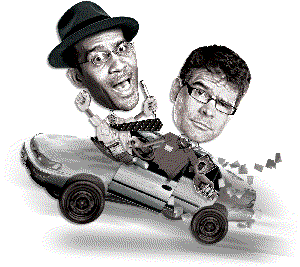

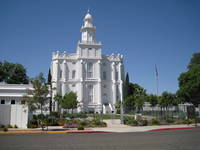
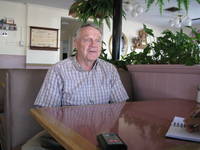
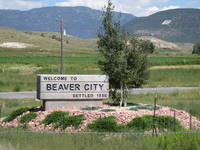
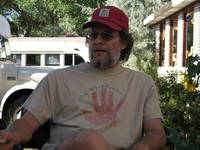
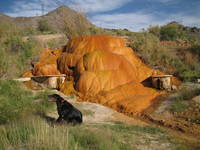
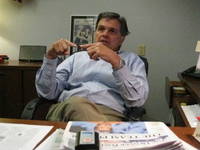
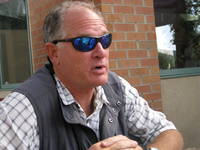
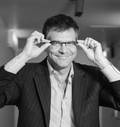

Previous Discussion: